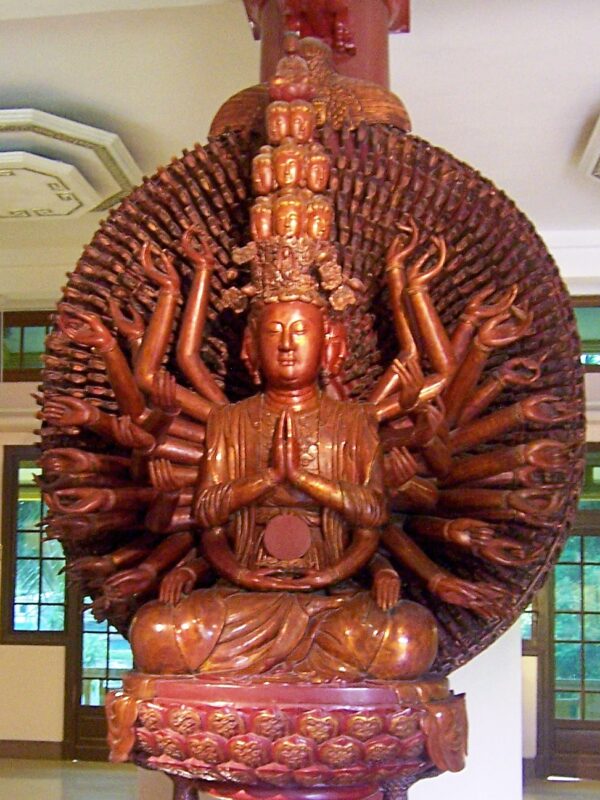
China Bridge (神州橋樑)_2011/May
Compassionate women
Since we were young, we Catholics have had a great love for Mary, the Mother of God. We have honoured her from the time the angel, Gabriel, announced the wishes of God and Mary gave her fiat to the will of God.
Throughout each year, we remember and celebrate the life of Mary in the life of Jesus from his birth in Bethlehem, his time in the temple discussing the scriptures with the elders when he was 12-years-old, to the marriage feast at Cana, when Mary told Jesus the host was running out of wine, and he performed his first miracle. She knew that her son was moving from town to town preaching the good news with many people believing in him and following him.
Mary, along with a few other compassionate women, was in Jerusalem standing at the foot of the cross when Jesus was crucified. As he had foretold, he was three days in the tomb and then rose from the dead on the day we now commemorate as Easter Sunday. Fifty days later, when the Holy Spirit descended on the apostles, Mary was with them. Pentecost marks the birth of the Church and from that time the apostles started to preach the good news.
We don’t know much more about Mary’s life, but she has not forgotten us. In fact, the Church has acknowledged many of her apparitions down through the ages in different countries. We have called on her in times of trouble, as we know she understands us and is compassionate.
Islam also honours Mary
The late Bishop Fulton Sheen wrote: “In the Qu’ran, the Virgin Mary is mentioned 30 times, with belief in her Immaculate Conception and also in her Virgin Birth.
“The Qu’ran also has verses on the annunciation, visitation and nativity. Angels are pictured as accompanying the Blessed Mother and saying: ‘Oh, Mary, God has chosen you and purified you, and elected you above all the women of the earth.’ Mary then is, for the Muslims, the true Sayyida, or Lady. The only possible serious rival to her in their creed would be Fatima, the daughter of Mohammed himself. But after the death of Fatima, Mohammed said, ‘Thou shall be the most blessed of all the women in Paradise, after Mary.’ In a variant of the text, Fatima is made to say, ‘I surpass all the women, except Mary’.”
Our Lady of Fatima
The bishop wrote, “Why did the Blessed Mother, in the 20th century, reveal herself in the significant little village of Fatima, Portugal so that to all future generations she would be known as, Our Lady of Fatima?”
He believed that the Blessed Virgin chose to be known as Our Lady of Fatima as a pledge and a sign of hope to the Muslims and as an assurance that they, who show her so much respect, will one day accept her divine son, too.
Muslims occupied Portugal for centuries. “At the time when they were finally driven out in the 12th century, the last Muslim chief had a beautiful daughter by the name of Fatima. A Christian, the Count of Ourém, fell in love with her and she not only stayed behind for him, but also embraced the Christian faith. The young husband was so much in love with her that he changed the name of the town where he lived to Fatima. Thus, the very place where Our Lady appeared in 1917 bears an historical connection to Fatima, the daughter of Mohammed.”
SOUL Magazine, September-October, 2001
“It is a fact that Muslims from various nations, especially from the Middle East, make so many pilgrimages to the Shrine of Fatima in Portugal that Portuguese officials have expressed concern” (soon after the bombing of the World Trade Centre in New York on 11 September 2001).
“The combination of an Islamic name and Islamic devotion to the Blessed Virgin Mary is a great attraction to Muslims.”
Another proof of the devotion of the Muslims to Our Lady: “When the Muslims invaded the Holy Land in the seventh century, they destroyed every Christian church, with one remarkable exception: the Basilica of St. Anne in Jerusalem, because it was believed to be built over the spot where the Blessed Virgin Mary was born. Their great reverence to Our Lady precluded the Muslims from destroying her birthplace.”
Spain
“As the Muslims swept through Spain in the eighth century, a great religious treasure was buried for safe-keeping in the earth, high in the Estremadura Mountains. It was a much-venerated statue of Our Lady holding the Divine Child Jesus that was a gift from Pope Gregory the Great to Bishop Leander of Seville. The image was uncovered in the year 1326, subsequent to a vision of Our Lady to a humble shepherd. Our Lady’s special statue was enshrined in a nearby Franciscan monastery next to what was called the Wolf River.
The Muslims had actually named the river. The Arabic term is Guadalupe: Guada, meaning river; lupe, meaning wolf. Hence, the famous image in Spain has been known, since the 14th century, by the Islamic name of Our Lady of Guadalupe.”
Mexico
Spanish missionaries faced grave resistance in the new world from the mighty Aztec people who worshipped an evil stone serpent god that demanded human sacrifice. Between 20,000 and 50,000 victims were sacrificed each year.
In 1531, Our Lady appeared to a humble Aztec convert by the name of Juan Diego. When, at the request of the local bishop, he asked her name, her response, in the Aztec language, included the words, te coatlaxopeuh (pronounced: te quatlasupe), which means “one who crushes the head of the stone serpent.”
To Juan Diego and his fellow Aztecs, this revelation had great meaning, coupled with the miraculous image of Our Lady standing on top of a crescent, the symbol of this evil serpent god. A tidal wave of conversions to Catholicism ensued. To the bishop’s Spanish ears, Our Lady’s Aztec name of Te Quatlasupe sounded just like the name of the revered Madonna from Spain with the Islamic name, Guadalupe. Hence, the bishop named the Mexican Madonna, Our Lady of Guadalupe.
Guan Yin 觀音

Guan Yin is one of the most beloved deities and Asian peoples have been worshipping her as the goddess of mercy and compassion for many centuries. Throughout Asia, altars dedicated to this mother of mercy can be found in temples, homes and wayside grottos, and prayers are incessantly on the lips of devotees, as they seek her guidance and help in every area of life. She is a motherly figure said to bestow children on the faithful, who is there for anyone in need of compassion and love.
Guan Yin is certainly one of the most adored of goddesses, not only among her own people, the Chinese, but the world. Many who worship her believe she is always looking after those in need of her care. Devotion to Guan Yin is likened to the veneration of our Holy Mother Mary and they share similar titles.
Guan Yin is the Holy Mother of Compassion and Mercy. She was, and is, a Buddhist bodhisattva (a mortal who has achieved enlightenment and earned the right to enter heaven or nirvana), who, when at the gates of heaven, heard someone on earth cry and turned back vowing that she would stay on earth to do all she could to ease the sufferings of people.
She vowed not to enter heaven until everyone could go there with her. Guan Yin said, “I am cultivating this method of great compassion and hope to save all living beings and any living being who calls my name or sees me will be free from all fear and danger. I will activate that being’s spiritual awareness and maintain it forever.”
We Catholics have many titles for our Blessed Mother and many of them are like the titles that Muslims and Buddhists have for the compassionate one in their own faith. People turn to Mary, and Guan Yin for favours and compassion.
Catholics all over the world have pilgrimages carrying statues or other images honouring Mary. Outside of Shanghai, in Sheshan (佘山), Chinese Catholics have pilgrimages to the shrine there, Our Lady Help of Christians. A few years ago, Buddhists in Taiwan carried Guan Yin’s statue on a pilgrimage to a Buddhist shrine, in Shaanxi (陕西), China.
Recently, hearing-impaired students of a school in China presented a dance depicting the thousand arms and heads of Guan Yin. Buddhists do not think of the bodisattva as a being separate from themselves.
When they see and hear the suffering of others and respond to that suffering, they are the heads and arms of the bodhisattva. The dancers are now known everywhere for their beautiful expression in dance of the bodisattva’s arms and heads.
The Buddhist saying goes:
As long as you are kind and there is love in your heart,
A thousand hands will naturally come to your aid,
As long as you are kind and there is love in your heart,
You will reach out with a thousand hands to help others
In Hong Kong, China and many parts of the world, we celebrate Mother’s Day in May. That is one day on which we give special thanks to our earthly mothers who taught us how to love and have compassion. Christians, Muslims and Buddhists are thankful to either Our Lady of Fatima, or Guan Yin for their compassion and protection. Happy Mother’s Day! 母亲节快乐!
MC
(Portions of this article were sourced from: http://www.michaeljournal.org/marymoslems.htm)


 ENG
ENG